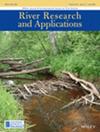在一条以地下水为主的白垩溪流中,拆除堰塞湖后在整个流域范围内改善生态环境的初步恢复情况
IF 1.9
4区 环境科学与生态学
Q4 ENVIRONMENTAL SCIENCES
引用次数: 0
摘要
物理生境改变是影响河流环境的主要压力之一,会影响河流生态系统的健康,削弱河流适应气候变化影响的能力。通过重振自然过程来消除物理改变的影响已成为全球公认的河流修复技术。在这里,我们通过评估英国一条以地下水为主的 "白垩 "河流对拆除围堰项目的生态反应来评估这种方法。通过使用 "控制影响前-控制影响后"(BACI)方法,我们发现,修复三年后,大型无脊椎动物群落在结构复杂性(如分类组成)和功能完整性(如性状组成)方面都在向目标群落靠拢。这一进展仍在继续,并与更大范围的集水区改善同步进行。我们的研究结果表明,白垩溪流等低能耗溪流的生态响应可能是渐进的,因此需要更长期的评估来全面评价生态恢复情况。我们强调了采用 BACI 方法了解当地对集水区恢复的反应的重要性。我们的研究结果还进一步证明,在项目后评估中同时评估分类学和功能特性可提供互补的生态信息。在未来的恢复规划中应更好地了解生态恢复时间。这些证据将有助于在适当的时间尺度上进行稳健的评估,从而提高准确有效地评估恢复项目成功的可能性,并有助于建立支持,扩大恢复行动的规模并加快步伐,以解决生物多样性丧失问题。本文章由计算机程序翻译,如有差异,请以英文原文为准。
Initial ecological recovery post‐weir removal amidst catchment‐wide improvements, in a groundwater‐dominated chalk stream
Physical habitat modification is one of the main pressures affecting river environments, impacting their ecosystem health and compromising their ability to adapt to the effects of climate change. Addressing the impacts of physical modification through reinvigorating natural processes has become a globally established river restoration technique. Here, we appraised such an approach by assessing ecological responses to a weir removal project on an English groundwater‐dominated ‘chalk’ stream. Using a Before‐After‐Control‐Impact (BACI) approach, we found that 3 years post‐restoration the macroinvertebrate communities are moving towards those of the target community both in terms of structural complexity (e.g., taxonomic composition) and functional integrity (e.g., trait composition). The progress is ongoing and has occurred alongside wider catchment improvements. Our results indicate that ecological responses to passive restoration undertaken on low energy streams, such as chalk streams, may be gradual, and thus longer‐term assessment is needed to fully appraise ecological recovery. We highlight the importance of a BACI approach to understand the local responses to restoration in a catchment context. Our findings also provide further evidence highlighting complementary ecological information provided by assessing taxonomic and functional properties concurrently in post‐project appraisals. A better understanding of ecological recovery times should be incorporated into future restoration planning. Such evidence would help develop robust assessments over appropriate timescales, increasing the likelihood of accurately and effectively appraising restoration project success, and helping to build support to increase the scale and pace of restoration actions needed to address biodiversity loss.
求助全文
通过发布文献求助,成功后即可免费获取论文全文。
去求助
来源期刊

River Research and Applications
环境科学-环境科学
CiteScore
4.60
自引率
9.10%
发文量
158
审稿时长
6 months
期刊介绍:
River Research and Applications , previously published as Regulated Rivers: Research and Management (1987-2001), is an international journal dedicated to the promotion of basic and applied scientific research on rivers. The journal publishes original scientific and technical papers on biological, ecological, geomorphological, hydrological, engineering and geographical aspects related to rivers in both the developed and developing world. Papers showing how basic studies and new science can be of use in applied problems associated with river management, regulation and restoration are encouraged as is interdisciplinary research concerned directly or indirectly with river management problems.
 求助内容:
求助内容: 应助结果提醒方式:
应助结果提醒方式:


